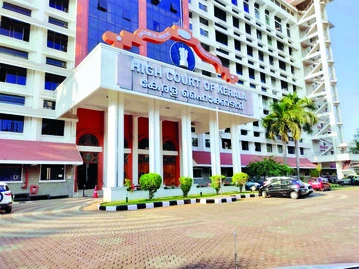By Sanjay Raman Sinha
A proposed bridge on Kerala’s Bharathapuzha River has become a contentious issue. E Sreedharan, known for his pioneering work on the Delhi Metro, has filed a Public Interest Litigation (PIL) in the Kerala High Court challenging the negligence of the state government to resolve the problem of realigning the Thiruvanaya-Thavanur Bridge across the Bharathapuzha River.
Two temples situated on both banks of the river form the holy “Trimurti sangama”, and Sreedharan asserts that this site of historical and religious significance will be disrupted by the bridge’s construction. Sreedharan wants the Kerala government to build the bridge without affecting the religious sanctity of the Holy Trinity temples. The construction of the bridge began with a grand celebration on September 8.
As the matter is now in court, many legal and constitutional points can be argued in favour of the proposed realignment of the bridge. Article 25 of the Constitution can be invoked which guarantees the freedom of conscience and the right to freely profess, practice and propagate religion, but subject to public order, morality and health.
The underlying premise in the PIL is that the proposed alignment of the bridge goes against the sanctity of the religious place and the consequent violation of religious sentiments associated with the Holy Trinity temples.
In many cases, courts have upheld religious rights as long as they are not in conflict with public interest or development. Furthermore, the Ancient Monuments and Archaeological Sites and Remains Act, 1958, could be invoked if the temples have historical or cultural importance. This Act prohibits construction near protected monuments. The realignment of the bridge can possibly protect the cultural heritage of the area where the temples are located. Sreedharan has built the case on the point that the bridge will divide the two temples and encroach upon the samadhi of K Kelappan. He has offered free technical expertise to resolve the issue.
Kelappan was a much revered freedom fighter christened as the “Kerala Gandhi”. His samadhi has historical significance and is revered by Hindus.
The case also involves aspects of urban and rural planning, and the policy dictum prescribes that the construction of public infrastructure projects must follow town planning guidelines. It must be mentioned that courts have intervened in cases involving public projects that potentially harm religious or cultural sites.
In the S Jagannath vs Union of India (1997), the ecological and social implications of commercial shrimp farming in India was judicially reassessed. In this case too, development projects were believed to be violating environmental norms and impacting local communities, and hence the Jagannath case can well be a judicial precedent.
Furthermore, in Ram Jankijee Deity vs State of Bihar (1999), the court stated that though the right to worship is provided and protected under Article 25, it must be balanced with public interest.
In TN Godavarman Thirumulpad vs Union of India (2006), the apex court stressed the balance between development and environmental protection. The Godavarman verdict resulted in the protection of large swathes of forest areas. The case lead to the cancellation of many projects which would have led to the diversion of forest land for non-forest purposes, and in the process, affected the habitat of forest communities.
In the Church of God vs KKR Majestic Colony Welfare Association (2000), the Supreme Court held that religious practices cannot transgress on public rights or welfare. The government could well make a case on this law point.
Sreedharan, who had successfully executed Konkan Railway and Delhi Metro, suggested the bridge be shifted to the southern edge by 200 metres. This shift will prevent the temples and the samadhi from being disturbed, thus preserving the religious and cultural sanctity of the area. Sreedharan argued that apart from cultural preservation, the construction costs will also be minimised.
Proponents of the bridge project held that each year, temporary bridges were being made to link the two panchayats for the annual Sarvodaya mela, and a permanent bridge would fulfill a long standing demand. They alleged that the PIL was politically motivated.
Furthermore, the bridge would improve access to the Vishnu temple on the other side of the river, facilitating devotees to reach both temples.
On the flip side, Sreedharan’s plea argues that the Bridge would affect the Navamukunda temple at Thirunavaya and the Cherutirunavaya Brahma-Siva temple, located on opposite sides of the Bharathapuzha river.
The 1.2 kilometre bridge has an estimated cost of Rs 48.83 crore and is scheduled to be completed in a year. The Kerala High Court is yet to order a stay on the project. The Court has asked the state government and other respondents to submit statements to ascertain whether there is any public interest involved in the project. The next hearing is scheduled on September 30.
Tempest over Temples
- Ayodhya Ram Janmabhoomi-Babri Masjid case (2019)
The Supreme Court in 2019 awarded the disputed land in Ayodhya to Hindus for the construction of a Ram temple, while providing a five-acre plot for a mosque elsewhere. The Court noted: “The right to practice and propagate religion is a fundamental right, but it does not mean that this right can be used to encroach upon others’ rights.”
- Sabarimala Temple case (2018)
The Supreme Court ruled that the prohibition on women of menstrual age entering the Sabarimala temple was unconstitutional. The Court observed: “Religious practices that are discriminatory against women cannot be considered part of the fundamental right to religion.”
- Sri Venkataramana Devaru vs State of Mysore (1958)
The Supreme Court upheld the right of a temple to manage its own affairs, observing: “State interference must be minimal in matters of religious practices, provided such practices do not violate fundamental rights.”


